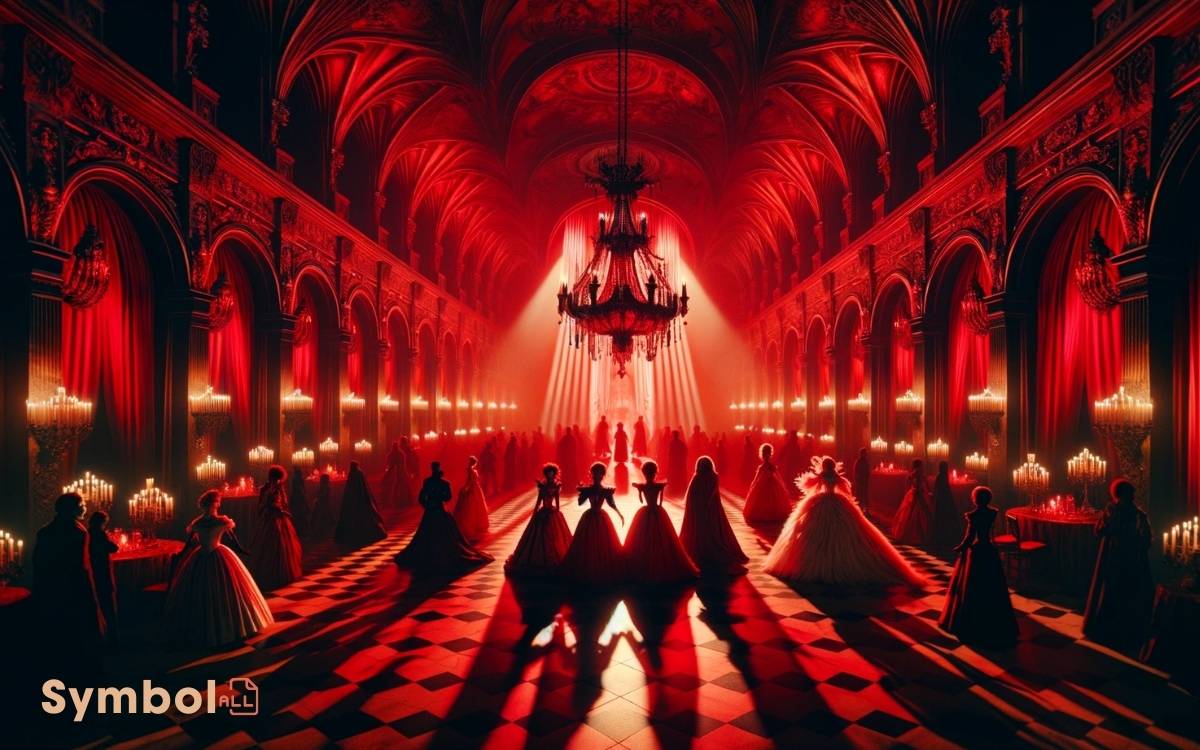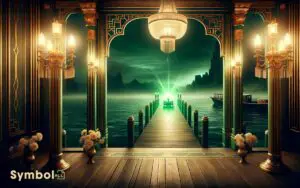Color Symbolism in Masque of the Red Death: Discoverd!
In “Masque of the Red Death” by Edgar Allan Poe, you find colors aren’t just for decoration. Blue’s calm offers a false sanctuary from chaos, while purple’s nobility hides life’s mysterious dualities.
Green whispers of youth’s fleeting vibrancy against death’s backdrop, and orange’s warmth hints at time’s relentless march.
White’s purity contrasts with the inescapable end, setting the stage for black and red’s finality: a stark memento of mortality and the blood of life’s conclusion.
Every hue weaves a deeper story of human fragility and the inevitability of death. Uncovering these layers reveals Poe’s rich tapestry of symbolism.

Key Takeaway
The Blue Rooms Tranquility
In Edgar Allan Poe’s ‘Masque of the Red Death,’ the blue room stands as a tranquil sanctuary, symbolizing a fleeting sense of peace amidst looming dread.
You’ll find that the color blue, often associated with calmness and serenity, here reflects a brief investigate for the story’s characters, who are desperately trying to escape the clutches of the Red Death.
This room, bathed in a calming hue, represents the illusion of safety and normalcy in a world that’s anything but.
As you explore further, you’ll notice how Poe masterfully uses this tranquil blue to contrast with the inevitable chaos and despair that engulfs the characters.
It’s a stark reminder of the fragility of life and the vain attempts at avoiding the inevitable.
Purple: A Regal Mystery
Delving deeper into the spectrum of Edgar Allan Poe’s ‘Masque of the Red Death’, the color purple cloaks itself in regality and mystery, offering a complex layer to the narrative’s symbolism.
This hue, often associated with nobility, signifies not only the social standing of the characters but also the enigmatic nature of life and death itself. It’s a reminder of the ultimate fate that awaits everyone, regardless of status.
| Aspect | Significance |
|---|---|
| Regality | Reflects high social standing |
| Mystery | Symbolizes the unknown aspects of life |
| Duality | Represents both life and death |
| Symbolic | Indicates impending doom |
| Interpretive | Invites deeper analysis |
Green for Youth and Growth
Exploring the vibrant tapestry of Edgar Allan Poe’s ‘Masque of the Red Death,’ you’ll find that the color green blooms with the themes of youth and growth, intricately woven into the narrative’s symbolic fabric.
This hue, often emblematic of life and renewal, underscores the stark contrast between the vibrancy of existence and the inexorable encroach of death.
Through the prism of green, Poe invites you to contemplate the fleeting nature of youth, its inherent vitality, and the inevitable process of aging.
This color, in its lushness, not only symbolizes the naive invincibility felt in youth but also hints at the growth that often comes from facing mortality—a poignant reminder of life’s transient beauty amidst the tale’s darker themes.
The Orange Rooms Warmth
As you journey deeper into Edgar Allan Poe’s ‘Masque of the Red Death,’ the orange room bathes the narrative in a warmth that symbolizes both false security and the inevitable passage of time.
This hue, often associated with sunsets and autumn, whispers of changes and conclusions rather than beginnings. It’s a clever choice by Poe, wrapping you in a comforting, yet unnervingly temporary embrace.
The orange light casts everything in a glow that might suggest safety and festivity, but under its luminescence, a more sinister undertone lurks. It reminds you that what seems bright and inviting can also herald the approach of darkness.
Here, Poe masterfully uses color to evoke a sense of fleeting tranquility, nudging you to question the reliability of perceived safety amidst life’s inevitable decay.
White: Innocence and Pallor
In Edgar Allan Poe’s ‘Masque of the Red Death,’ the white room stands as a stark symbol of innocence and the chilling pallor of death, inviting you to peel back layers of meaning behind its seemingly pure facade.
This room, unlike the others, embodies a dual nature that you can’t ignore. It represents both the untarnished innocence of life and the inevitable end that awaits us all, manifesting Poe’s contemplation on the cycle of life and death.
| Aspect | Significance |
|---|---|
| Color White | Symbolizes purity and innocence |
| Chilling Pallor | Represents death and the end |
| Dual Nature | Reflects life’s cycle and inevitable conclusion |
| Stark Contrast | Highlights the room’s unique symbolism |
| Interpretive Depth | Invites deeper analysis and understanding |
Through this room, you’re encouraged to confront the uncomfortable truth that innocence is often intertwined with mortality, prompting a reflection on the transient nature of life itself.
The Finality in Black and Red
Moving beyond the innocence and pallor symbolized by white, you’ll now encounter the profound finality embedded in the hues of black and red within Edgar Allan Poe’s ‘Masque of the Red Death.’
Black, often associated with death and the unknown, represents the inevitable end that awaits us all. Red, on the other hand, symbolizes the visceral, the lifeblood that ebbs away at death’s touch.
Together, these colors paint a stark reminder of mortality, wrapping the narrative in a cloak of inevitability. Poe masterfully uses these colors not just for atmosphere but to foreshadow the inescapable demise of all the guests.
You’re drawn into a world where the end isn’t just a possibility—it’s a certainty, underscored by the chilling finality of black and red.
Conclusion
As you’ve journeyed through the color-laden halls of ‘The Masque of the Red Death,’ each hue whispers secrets of life, from tranquil blues to the foreboding black and red room where death holds court. Colors aren’t just paint on the walls; they’re the story’s beating heart, pulsing with symbolism. Each shade crafts a vivid narrative, pulling you deeper into the allegory of existence and mortality. The juxtaposition of white chrysanthemums and death symbolism emerges powerfully, hinting at the delicate dance between purity and the inevitable end. In this chromatic maze, every color demands reflection, urging us to confront the fragility of human life.
Like a painter with a palette, Poe masterfully mixes shades of meaning, inviting you to look beyond the surface. In the end, death’s rainbow reveals that no one escapes life’s final masquerade.






